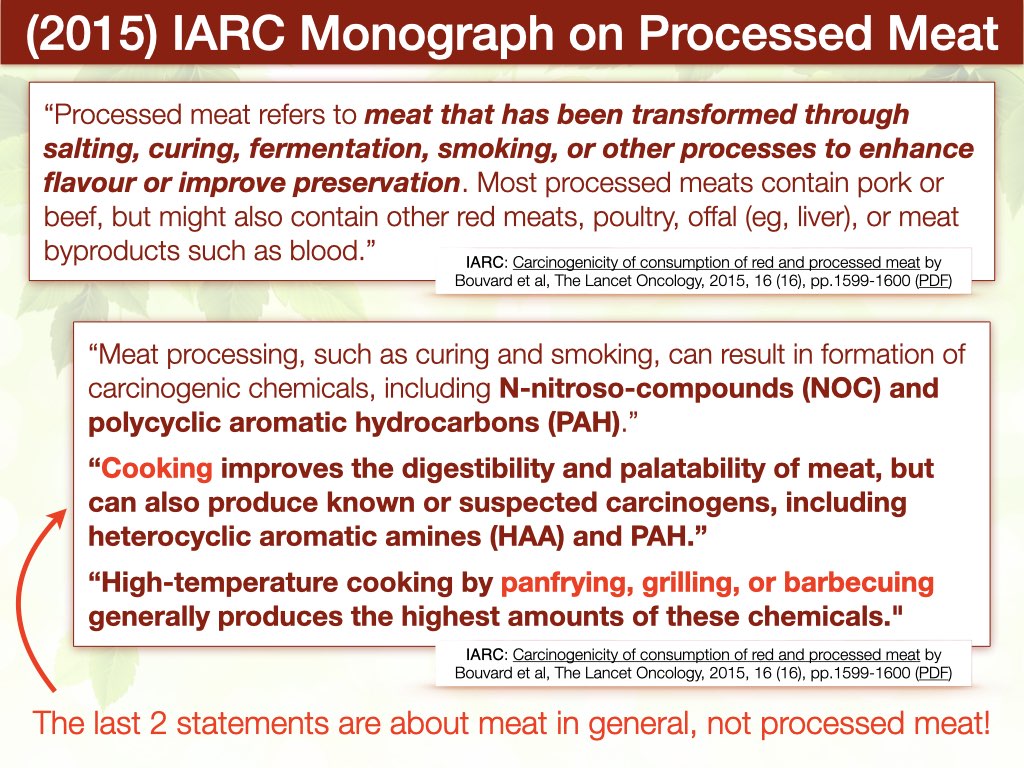
In other words, even fresh meat when cooked at home may produce HAA (heterocyclic amines) and PAH (polycyclic aromatic hydrocarbons), which are known or suspected carcinogens! And high-temperature cooking by panfrying, grilling and barbecueing produces the highest amounts of such chemicals! So what has stopped IARC from saying that all meat is carcinogenic? I don't know. Perhaps the 'degree of evidence' is not strong enough (yet).
Excerpts from How to Reduce the Cancer-Causing Properties of Meat (2022) by Dr Greger:
Does cooking of meat produce carcinogens?
Do meat fumes cause cancer?
What else in meat may cause cancer?
Keeping chemical toxins in mind, how many servings of meat should we consume?
Processed Meat is an IARC Group 1 Carcinogen: What is 'processed meat'? Why did IARC classify it as a Group 1 carcinogen (which means that 'sufficient evidence in humans' and 'causality established')?
Nitrites in Processed Meat: "Nitrites in processed meat form nitrosamines, a class of potent carcinogens found in cigarette smoke, which may explain why hot dog consumption has been associated with the two leading pediatric cancers, brain tumors and childhood leukemia." — Dr Greger
n-Nitroso Compounds In Meat: Processed meat was classified as IARC Group 1 carcinogen in 2015 because of compounds like N-nitroso-compounds (NOC). How harmful are these compounds? How are they produced? Dr Greger explains.
Carcinogens in Cooked Animal Products: Dr Greger explains that undercooked meat exposes us to the risk of food poisoning. On the other hand, well-cooked meat may expose us to carcinogens like HCA and PAH! Even meat fumes are suspected to be carcinogenic. In one of his videos, he suggests that boiling meat allows non-vegetarians to mediate their risk of both.
AGEs: Advanced Glycation End-products: Advanced Glycation End-Products (AGEs) are associated with inflammation in our body and chronic health conditions like cancer. Where are AGEs found? How may we reduce their intake?
TOR Overactivation: What is TOR? What causes TOR overactivation? Does TOR overactivation promote cancer, autism and many other chronic lifestyle conditions?
TMAO: In recent years, a new mechanism has been proposed to explain heart disease and cancer: TMAO. Story in brief: (a) carnitine and choline are converted by our gut bacteria into TMAO, and (b) TMAO contributes to heart disease, stroke, cancer and impairs kidney function.
Heme Iron: "Heme iron, the type found predominantly in blood and muscle, is absorbed better than the non-heme iron that predominates in plants, but may increase the risk of cancer, stroke, heart disease, and metabolic syndrome." — Dr Greger
Viruses in Food (Meat): Viruses in meat and eggs are being implicated in incidence of cancers like breast cancer, liver cancer and pancreatic cancer.
Neu5Gc: In 2012, Dr Greger published a 7-part video series summarizing the role of Neu5Gc, a molecule in meat that promotes inflammation and tumor growth.
Methionine Restriction and Leucine Restriction: High intakes of methionine and leucine are associated with increased risk of cancer and reduced lifespan. Where are excess methionine and leucine found? In animal products!
Dr Peter Rogers: See Does Meat Cause Cancer? Dr Peter Rogers enumerates 30+ direct and indirect pathways through which meat is known or suspected to cause cancer. For example, meat is a high calorie density food. High calorie density foods encourage overeating which may lead to obesity. Obesity is associated with increased risk for chronic inflammation and myriad health conditions, which means that our cancer risk goes up! Specifically, obesity is associated with higher risk for high cholesterol levels, high estrogen levels and insulin resistance, all of which are known risk factors for cancer.
Animal Protein & Cancer: A technical summary for animal protein intake and cancer is found here: Chapter 13 of Proteinaholic (free PDF) by Dr Garth Davis.
An interesting summary of animal fats and heart disease is found in the book Oversaturated: A Guide to Conversations about Fats with Your Patients (236 pages, 2019) by Dr Evan Allen.

 Instagram
Instagram YouTube
YouTube